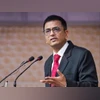Chief Justice of India DY Chandrachud said on Saturday that optimising tech within the judiciary is not just about modernisation but also a strategic move towards democratising access to justice, and underlined the need to train lawyers to use technology.
Leveraging these advancements will help bridge gaps, enhance efficiency, and ensure that justice delivery is not impeded by geographical and technological barriers, he said while addressing a gathering at the inauguration of a new district court building here.
Highlighting the importance of district courts, Justice Chandrachud said they hold a crucial position for the realisation of the right to justice and are a cornerstone of the ideals of our Constitution in envisioning a society where every citizen is assured that right to justice.
Talking about the new court building in Rajkot, he called the inclusion of a conference room and a training room, equipped with the latest audio-video devices and systems, a forward-looking feature.
This resonates with the hybrid and online conferencing systems implemented in the courtrooms of the Supreme Court, adapting to the changing times and leveraging technologies for the swift delivery of justice, Justice Chandrachud said.
Optimising technology within the judiciary is not just about modernisation, it is a strategic move towards democratising access to justice. By leveraging these advancements, we aim to bridge gaps, enhance efficiency, and ensure that justice delivery is not impeded by geographical and technological barriers, he said.
With the Supreme Court about to launch the construction of its new futuristic building with 27 courtrooms equipped with the latest technology and facilities for stakeholders, Chandrachud said, he felt inspired by the new building of the district court in Rajkot.
More From This Section
He also appealed to the principal district judge to ensure that lawyers are trained in the use of technology and should not be separated from judges in that aspect.
District courts emerge as an initial point of recourse for every citizen who seeks redress. Citizens do not come to the Supreme Court first and foremost, they come to the district courts. So in your work as members of the bar, you will generate confidence or lack of confidence in the citizens, he said.
He also mentioned his visit to the temples at Somnath and Dwarka. He said the dhwaja (flag) of the Dwarkadheesh temple, which is similar to the one at the temple of Lord Jagannath at Puri in Odisha, has a special meaning for the people from the judicial community.
Look at this universality of transition in our nation which binds all of us together. This 'dhwaja' has a special meaning for us, and that meaning which the 'dhwaja' gives us is that there is some unifying force above all of us, as lawyers, judges, and citizens and that unifying force is our humanity, which is governed by the rule of law and Constitution of India, he said.
Beyond the mere physical structure, our building represents a commitment and a promise a promise that the pursuit of justice within its wall will be characterised by swiftness, accessibility and impartiality, he added.
Talking about the zero waste facility' at Somnath temple, Justice Chandrachud said it should become an inspiration for turning every court system in the state into a "zero waste" facility.
It is then that we will be truly inspired by the ideals of this great temple which dots the landscape of the state of Gujarat, he said.
He also recalled the COVID-19 pandemic when he and Justice (retired) MR Shah were not able to even physically access the Supreme Court, but that did not prevent them from dealing with not only urgent cases but also all the cases that came up before their bench.
The CJI sought to highlight another feature of the new court building in Rajkot, saying it has cared about young women lawyers by building separate washrooms for them.
Something as elementary as having separate bathrooms and adequate number of bathrooms for young women lawyers defines the social progress of the judiciary for the future, he said.
It may appear to be very simple, but please remember that this is not the position in every part of the country. And therefore you are very privileged to have this in the state of Gujarat, he stressed.
The amalgamation of courtrooms into one centralised location has streamlined the legal process and reduced the burden on legal professionals and those seeking justice, he said. The CJI said that the court building also has new vulnerable witness deposition centres for child witnesses and women who are victims of gender violence.
We have an ADR (alternative dispute resolution) system which promotes the principle mediate, don't litigate'. Mediation does not take away work from lawyers, it creates new works for lawyers. Across India today, lawyers are at the forefront of the mediation movement, he added.

)
